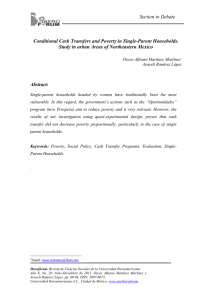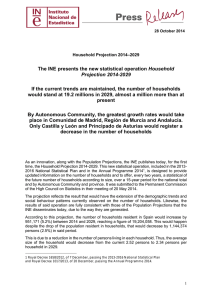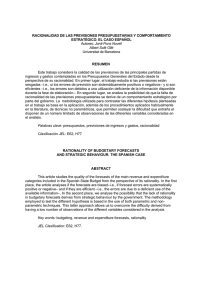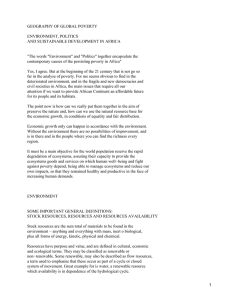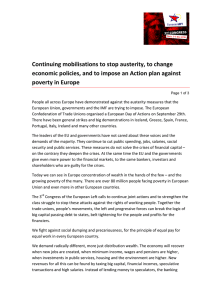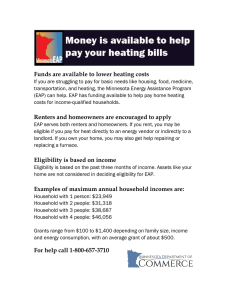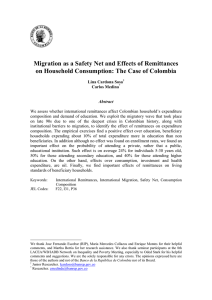A demand system analysis of food for poor and non poor households
Anuncio
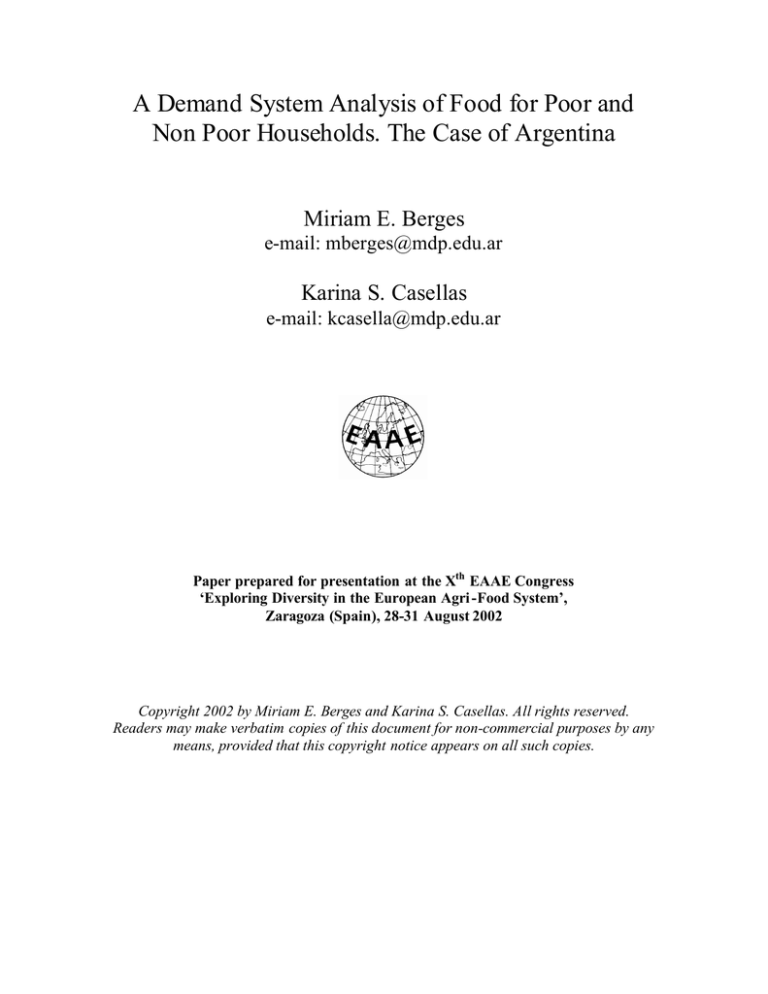
A Demand System Analysis of Food for Poor and Non Poor Households. The Case of Argentina Miriam E. Berges e-mail: mberges@mdp.edu.ar Karina S. Casellas e-mail: kcasella@mdp.edu.ar Paper prepared for presentation at the Xth EAAE Congress ‘Exploring Diversity in the European Agri -Food System’, Zaragoza (Spain), 28-31 August 2002 Copyright 2002 by Miriam E. Berges and Karina S. Casellas. All rights reserved. Readers may make verbatim copies of this document for non-commercial purposes by any means, provided that this copyright notice appears on all such copies. A DEMAND SYSTEM ANALYSIS OF FOOD FOR POOR AND NON POOR HOUSEHOLDS. THE CASE OF ARGENTINA Berges, Miriam E. mberges@mdp.edu.ar Casellas, Karina S. kcasella@mdp.edu.ar Mar del Plata University. (Argentina) Faculty of Social and Economic Sciences Phone (Fax) (54223) 474-9696 January 2002 A DEMAND SYSTEM ANALYSIS OF FOOD FOR POOR AND NON POOR HOUSEHOLDS. THE CASE OF ARGENTINA Abstract The purpose of this paper is to provide some microeconomics tools to discuss and evaluate public policies that imply transfers of income from the public sector to the poor and their impact on their food demand and calories and nutrient intakes. This study is concerned with the differences in subsistence expenditures, own-price elasticities and income elasticities for two households groups segmented by income: those people below the poverty guideline and those above it. The attention of our research is focused on a demand system for all food groups included in a National Consumption Survey and examines the household food consumption behavior by partitioning the sample. A complete system of demand equations, the Linear Expenditure System (LES), has been used due to its relative empirical expediency. Some additional econometric techniques to correct the bias in the parameter estimates were also applied because of the large number of zero observations in the data. Preliminary estimations following the procedure suggested in the Park et al. (1996) paper, gave some results that they were not as good as we expected and we finally use an alternative one based on Shonkwiler and Yen (1999). Key words: Food Demand System, Censored Sample, Own-Price and Income Elasticities, Poverty Status A DEMAND SYSTEM ANALYSIS OF FOOD FOR POOR AND NON POOR HOUSEHOLDS. THE CASE OF ARGENTINA The relationship among income level, poverty line, and nutritional status has a long history in the applied economic literature. In the last five years there has been a large number of papers about these topics in Argentina. The increasing unemployment rate and the decrease in the domestic production have encourage the research in income distribution, labor market behavior and inequality of opportunities, but few of them have focused on consumer behavior.1 According with this situation, lower-income groups of population are not able to achieve a basic food basket that satisfies a minimum nutritional status and therefore, the demand for public policies to improve this situation have increased. These public policies and government food assistance programs that may be either food quantities or certain amount of money, directed to those households below the poverty line are being applied in Argentina. The purpose of this paper is to provide some microeconomics tools to discuss and evaluate public policies that imply transfers of income from the public sector to the poor and their impact on their food demand and calories and nutrient intakes. As PinstrupAndersen and Caicedo (1978) said “the utilization of average estimates of price and income elasticities for the population as a whole for the projection of individual commodity demands is not likely to be very successful if significant changes occur in income distribution”. The results showed that the parameter estimates change at different levels of income. We agree with Park, Holcomb, Raper and Capps (1996) that when “visible changes have occurred in income distribution, commodity demand projections should be based on individual income strata than on average estimates of price and income elasticities”. This paper is concerned with the differences in subsistence expenditures, own-price elasticities and income elasticities for two households groups segmented by income: those people below the poverty guideline and those above it. The attention of our research is focused on a demand system for all food groups included in a National Consumption Survey2 and examines the household food consumption behavior by partitioning the sample. The poverty line used in the paper was estimated by the Social Programs Information and Evaluation System (SIEMPRO) depending on the Social Development Ministry in Argentina.3 A complete system of demand equations, the Linear Expenditure System (LES), has been used due to its relative empirical expediency. The data provided by the mentioned National Survey (ENGHO) accounts with a sample size of 27,260 households. They include the money value, the quantities and type of food purchased by the households over a one-week period (March 96-April 97). Some additional econometric techniques to correct the bias in the parameter estimates were also applied because of the large number of zero observations in the data. Preliminary estimations following the procedure suggested in the 1 See Rodríguez, E.; Berges, M. and Casellas, K. (2000) The first and most recent survey in Argentina for the whole urban population (ENGHO) provided by the National Statistics and Census Institute (INDEC) during 1996. 3 It estimates regional poverty guidelines based on the budget required to buy a set of basic necessities. It differs in terms of household size, region and household owner or tenant status. 2 1 Park et al. paper, gave some results that they were not as good as we expected and we finally use an alternative one4 based on Shonkwiler and Yen (1999).5 Data The sample for this analysis includes 27,260 households, that is, the whole survey with complete information for each household. This survey provides quantities, but not prices, therefore the latter were estimated. The aggregate food groups are: 1) sugar; 2) alcoholic beverages; 3) non-alcoholic beverages; 4) all the meats except poultry; 5) flours, rice and cereals; 6) ready to eat meals; 7) sweets; 8) ham, sausages and others; 9) fruits; 10) fats and oils; 11) eggs; 12) coffee, tea and spices 13) milk; 14) dairy products; 15) pastas; 16) poultry; 17) bread and cookies; 18) vegetables. The quantities of the Food away from home group are not provided by the survey, because of it, this group had to be excluded of the analysis. Tables I and II show the means of expenditures and adjusted prices, their standard deviation and the data density for both poverty and non poverty status group. In addition a number of socio-economic characteristics are included in the tables. The households below the poverty guideline have a greater size, a large number of children and a lower level of education than the other group. Their mean expenditures are sensitively smaller, however the average adjusted prices are not very different. In general, the adjusted price standard deviation increases with higher incomes, but both groups means do not differ substantially. Even average prices for commodities such as eggs and sugar are higher for the lowerincome group.6 Therefore, the subsistence quantities for these households should be smaller. 4 We are very gratefully to R. Holcomb, who suggested us this alternative methodology. Our objective is not to discuss the methodological implications which are widely treated in the reference paper, but our results are in accordance with those reported by the simulation presented on that one. 6 This fact could be explained by the high incidence of small retailers on these households purchases. 5 2 Table I. Poverty Status Households. Descriptive Statistics. (n= 10,239) Food groups Sugar Alcoholic beverages Non-alcoholic beverages Meats7 Rice, flour and cereals Ready to eat meals Sweets Ham, salami, sausages Fruits Fat and oils Eggs Coffee, tea, spice and condiments Milk Dairy products Pastas Poultry Bread and cookies Vegetables Total Food Expenditures Per Capita Income 7 Expenditures Mean Standard deviation 3.58 6.28 6.31 14.18 Adjusted Prices Mean Standard deviation 0.714 0.117 1.265 0.389 12.57 15.99 0.965 0.467 0.691 49.80 3.88 40.5 5.83 3.178 1.465 0.821 0.706 0.932 0.516 6.25 15.94 8.289 2.207 0.329 4.75 3.83 9.78 8.10 3.834 6.717 3.189 1.282 0.423 0.335 10.13 6.48 4.97 8.25 13.34 9.18 5.68 11.5 1.231 2.519 0.129 5.436 0.628 0.943 0.025 5.240 0.640 0.537 0.665 0.634 12.37 7.23 11.4 9.75 31.18 14.55 11.37 17.09 16.25 23.09 0.776 5.518 2.514 2.641 1.708 0.175 2.281 0.966 0.445 0.547 0.636 0.492 0.706 0.372 0.954 20.64 17.58 0.835 0.381 0.924 Mean 213.39 Std Deviation 138.57 Mean 456.33 Std Deviation 266.02 100.05 43.67 4.83 2.29 Household Income Household Size Data density 0.502 0.339 Beef, pork, lamb and fish 3 Table II. Non-Poverty Status Households. Descriptive Statistics. (n= 17,021) Food groups Sugar Alcoholic beverages Non-alcoholic beverages Meats Rice, flour and cereals Ready to eat meals Sweets Ham, salami, sausages Fruits Fat and oils Eggs Coffee, tea, spice and condiments Milk Dairy products Pastas Poultry Bread and cookies Vegetables Total Food Expenditures Per Capita Income Expenditures Mean Standard deviation 2.355 4.875 11.201 25.600 Adjusted Prices Mean Standard deviation 0.713 0.114 1.268 0.930 22.363 26.381 0.955 0.438 0.778 55.304 3.952 50.918 7.414 3.256 1.481 0.962 1.192 0.877 0.414 17.602 37.028 8.326 3.646 0.476 10.077 7.453 18.650 12.436 3.830 6.783 5.136 2.180 0.509 0.466 18.122 7.178 5.041 10.929 19.029 10.811 5.821 16.127 1.251 2.549 0.129 5.580 0.739 1.269 0.025 7.096 0.803 0.502 0.620 0.599 13.469 15.370 12.241 15.959 29.810 15.776 20.178 17.278 20.824 22.509 0.786 5.524 2.599 2.650 1.756 0.212 2.359 1.582 0.899 0.847 0.711 0.665 0.656 0.529 0.967 23.989 22.094 0.852 0.533 0.899 Mean 282.42 Std Deviation 198.23 Mean 1363.53 Std Deviation 1237.23 475.36 473.43 3.20 1.65 Household Income Household Size Data density 0.385 0.423 An analysis of the two groups composition as exhibited in Table III reveales some interesting differences. We find out that approximately 50% of poor families reside in the North and Cuyo regions and that 65% of non-poor are mainly located in the Pampeana and Patagonica regions as well as in Metropolitan zone. Only 4% of the household heads have university educational level in the poverty group, while this percentage reaches 22.5% in the other status group. The share of purchases at supermarkets exceeds 50% of food expenditures only for 13% of the poor households, and increases to 24% of the non-poor. 4 Table III. Percentage of Households in each Demographic Category Category Poverty Status Group Percentage Nonpoverty Status Group Percentage Poverty Status in the Region Percentage 11.57 25.59 22.39 17.19 12.86 10.40 100% 21.87 30.10 15.04 9.26 10.27 13.46 100% 34.60 45.95 59.82 64.99 55.60 43.59 37.89 Education level Low High 30.36 4.22 14.06 22.49 Quintile First Fifth 51.60 ----- ---32.52 13.19 23.70 Region R1-MetropolitanR2-PampeanaR3-NorthwestR4-NortheastR5-CuyoR6-Patagonica- Share of food purchases at supermarket > 0.50 Theoretical Issues a) System of demand equations The estimation of the complete demand system is important in identifying the interdependence among goods, and specifically the effect of changes in one particular good price on the demand for the other goods. One of the widely used functional forms derived from maximization of the utility function under budget constraint is the Linear Expenditure System (LES) (Intriligator, 1996). The reasons for using it are : 1) it has a straightforward and reasonable interpretation, 2) it is one of the few systems that automatically satisfy all the demand theoretical restrictions and 3) it can be derived from a specific utility function, the Stone-Geary.8 The system is estimated from the data on quantities (xj) and prices (pj) of the n goods and data on income or total expenditure. The parameters that are estimated are the n base quantities γ1, γ2,..... γn and the n marginal budget shares β1, β2, .... βn.. The model can be written as: (1) pj xj = pj γj + βj (I - Σ pk γk) k=1 j = 1,2,.....n 8 This function assume a Cobb-Douglas function with an origin P –the subsistence quantities- with linear Engel curves. U = (x1 -γ1)α (x2 -γ1)β α + β = 1. Separability is assumed and it is more plausible when we use broad groups of goods. Their marginal utilities are independent of any other good quantity. There are not cross substitution effects. 5 and xj - γj >0, 0 < βj < 1, Σ βj = 1 This system can be interpreted as stating that expenditure on good j, given as pjxj, can be decomposed into two components. The first is the expenditure on a certain “base amount” γj of good j , which is the minimum expenditure to which the consumer is committed. The second is a fraction βj of the supernumerary income defined as the income above the “subsistence income” (Σ pk γk ) needed to purchase the base amount of all goods. Since βj >0, this system does not allow for inferior goods and all of them behave as gross complementary goods. Dividing the equations by the price (pj ) gives the corresponding system of demand equations which is hyperbolic in own price and linear in income. The demand curve can be written as: __ __ _ (2) xj = γj (1- βj ) + βj ( Ī - Σ pk γk) pj –1 And the Engel curve is of the form ____ __ _ _ (3) Ej = pjxj = ( pj γj - βj Σ pk γk ) + βj I _ _ _ _ Since this system implies linear Engel functions, a specification not supported in the practice and that can at best be true only over a short range of income. If the equations are to be used for predictions, only short-term predictions can consequently be made. The price and expenditure elasticities that derive from this system are: (4) εjj = -1 +[ (1-βj ) γj ] / xj (5) εji = -βj γi pi / xj pj (6) ηj = βj yi / xj pj The estimation of the LES is difficult due to nonlinearity in the coefficients β and γ, which enter in a multiplicative form. Some iterative approaches have been followed to overcome this difficulty. One is two-stage procedure and the other the full information maximum likelihood technique. b) Quality adjusted prices Quality adjusted prices should be used to estimate commodity demand functions from cross sectional data because otherwise the potential distortions from not adjusting cross sectional prices for qualities effects, will increase with heterogeneity of the commodity aggregate. Cox and Wohlgenant demonstrated the importance of adjusting prices for quality differences among households to account for price variation.9 Following this approach the adjustments were made to prices by regressing the imputed prices on selected social and demographic characteristics. 9 They assume that the household first determines commodity quality through the selection of component goods and then the quantity of a composite commodity. This means the household quality decision (as reflected in the quality/price function) can be modeled independently of the quantity decision at the commodity level. 6 7) Pj = β0 + β1 Dalto + β2Dbajo + β3Djsexo + β4Dquin1 + β5Dquin5 + β6DR1 + β7DR3 + β8DR4 + β9DR5 + β10DR6 + β11Ing + β12Miembros + β13Prgalhip +ξ The variables include pj , the imputed price of the jth food group; Dalto y Dbajo binary variables are, respectively, the high and low education level for household heads; Djsexo, a binary variable if the household head is female; Dquin1, a binary variable representing the household located in the first quintile dummy; Dquin5, a binary variable representing the household located in the fifth quintile dummy; DR1, DR3, DR4, DR5 y DR6, binary variables dummy representing the regions of the country (Metropolitan, Northwest, Northeast, Cuyo y Patagónica); Ing, monthly income; Miembros, the household size and Prgalhip, the share of food expenditure at supermarkets. Quality adjusted prices were then generated adding the intercept of equation 7) to the residuals of 7) (Cox and Wohlgenant). When either expenditure or quantity was zero, the adjusted price was equal to the intercept. The generation of these prices admits the possibility that some of them may be negative. This situation suggests that, after accounting for quality differences, one would have to pay a particular household to consume the good in question. c) The censored response problem. Some households did not consume certain food groups, resulting in the dependent variable having a value of zero for that observation. The principal reasons are: 1) infrequency of purchase because the period of the survey is too short, 2) consumers preference and 3) consumers do not purchase the good at the current prices and income levels (corner solution). The zero expenditure presents an empirical difficulty of censored response bias. Heckman´s two step technique is used to resolve this censored response problem. This analysis employs a generalization of the Heien and Wessells and Hein and Durham to account for zero expenditure. The first step involves a probit regression to determinate the probability that a given household would purchase the good in question. From this information we compute the Inverse Mills Ratios (IMR). Therefore: 8) Pr [ Zij = 1] = φ (Wi δj) Pr [ Zij = 0] = 1− φ (Wi δj ) where Zij the binary dependent variable, φ the standard normal cumulative distribution function (CDF), Wi the vector of regressors related to the purchase decisions as household head’s age, educational level, geographic region, per capita income, squared income, household size, product of members by income, household with freezer, household with a female household head, number of children under fourteen, number of persons over sixtyfive and the ratio between non-working and working people in the household, and δj the coefficient vector associated with the regressors. The IRM generated by the probit is described as: 9) IMRij = φ (Wi δj) /φ (Wi δj) si Zij = 1 7 IMRij = φ (Wi δj) /1- φ (Wi δj) si Zij = 0 where φ the standard normal probability density function (PDF). The second stage of the procedure involves the estimation of a LES with the IRM used as an instrumental variable. All observations are used for the second step estimation. A separate demand system is estimated for each group and each equation within the LES was augmented with the IRM to account for any bias resulting from zero values in the dependent variables. Rewriting the equation 1) as: 10) pji xji = pji γj + βj (Ii - Σ pki γk ) + αj IMRij + vj However, a most recent developing by Shonkwiler and Yen (1999) has shown, using Monte Carlo simulation, that the procedure in two steps that they propose for equations systems with limited dependent variables yields consistent estimations and behaves better than that the one proposed by Heien and Wessels.10 Instead of using the IMR as an additional explanatory variable in the equation, Shonkwiler and Yen multiplies the explanatory variables by the CDF and has the PDF as an additional explanatory variable in each equation.11 We can rewrite the system: 10) pji xji = pji γj φ (Wi δj) + βj φ (Wi δj) (Ii - Σ pki γk ) + αj φ (Wi δj) + vj Using this alternative method, we have calculated the price and expenditure elasticities as follow: 11) εjj = -1 + [ (1-βj ) φ (Wi δj) γj ] / xj 12) Ej = βj φ (Wi δj) ei / xj pj where ei / xj pj is the expenditure share in the good j in the total food expenditure. Empirical Results The second stage estimates were calculated using Seemingly Unrelated Regression (SUR). To avoid singularity of the variance-covariance matrix of the disturbance terms, the equation for Ready to Eat Food was excluded from the system estimation. Its parameter β was obtained from the difference between the unity and the others coefficients. 12 10 Shonkwiler and Yen say there is an internal inconsistency in Heien and Wessels’ model. “...the unconditional expectation of yji is f(xji,βj). However the system suggests that as W´ij δj → - ∞ then yji → 0 as one would expect.” (pp 973) 11 As E(yji | x,w:ε >- W´ij δj)= f(xji,βj)+ αj [φ (Wi δj) /φ (Wi δj)] and E(yji | x,w:ε ≤ - W´ij δj)= 0, the unconditioned mean is: E(yji | x,wj) = φ (Wi δj ) f(xji,βj) +αj φ (Wi δj). 12 Econometric Software was Eviews 4.0 8 Tables IV and V show γj and βj parameters redefined by multiplying the estimates by the normal cumulated distribution function of the probit forecast means.13 All subsistence quantities are smaller than mean quantities and all estimates are significant (at the 5% level) except for a few parameters, as t-values reported in the tables show. Non-alcoholic beverages; sweets; fruits14; fat and oils; coffee, tea, spices and dairy products have negative subsistence quantities in the poverty status group.15 In accordance with the theory, own-price elasticities should be more elastic. In the higher-income group, only two of the commodities mentioned above have negative subsistence quantities but they are very close to zero and their estimates are not significant at the 20% level. Table IV. Parameter estimates for Poverty Status Group Commodity Groups Sugar Alcoholic beverages Non-alcoholic beverages Meats Rice, flour and cereals Ready to eat meals Parameter βj αj 1.52 0.018 -1.214 (3.79) (45.6) (-1.52) 2.78 0.037 -8.356 (9.43) (41.8) (-8.028) -0.55 0.066 8.565 (-1.97) (73.8) (7.97) 5.18 0.209 1.128 (15.01) (107.6) (0.309) 0.71 0.017 0.168 (10.5) (48.3) (0.47) 0.26 0.059 - (5.82) Sweets Ham, salami, sausages Fruits Fat and oils Eggs Coffee, tea, spice and condiments Estimates γj R2 0.17 0.17 0.33 0.54 0.19 - - -0.02 0.032 -1.097 (-0.95) (56.9) (-2.32) 0.51 0.019 -7.290 (9.72) (37.8) (-7.87) -0.22 0.053 6.183 (-1.28) (69.3) (7.23) -0.19 0.034 4.231 (-2.61) (65.4) (6.92) 8.12 0.019 2.916 (4.44) (53.3) (4.02) -0.11 0.048 3.650 (-6.57) (76.3) (6.27) 0.24 0.15 0.31 0.29 0.22 0.36 13 Shonkwiler and Yen demonstrate that the second-step ML or SUR estimator obtained by the usual procedure is inefficient because of the error terms are heteroskedastic. They suggest to use a weighted system estimator to account for the specific type of heteroskedasticity. We could not satisfactory apply this last estimator and in consequence, our estimates are inefficient. 14 The latter two commodities have not significant estimates for γj . 15 This situation suggests that poor households should be willing to pay to keep from consuming these food items. That explanation doesn’t sit well and it is probably not the reason we have the negative subsistence quantities. It is very likely that our data has a heteroskedasticity problem. 9 Milk Dairy products Pastas Poultry Bread and cookies Vegetables 2.07 0.051 7.934 (3.29) (58.3) (5.41) -0.32 0.039 7.960 (-7.81) (57.2) (10.35) 1.00 0.062 -3.132 (7.27) (61.9) (-2.51) 2.18 0.047 -9.471 (8.34) (45.6) (-5.21) 3.46 0.104 35.205 (10.04) (81.3) (14.5) 1.56 0.086 21.449 (4.51) (95.8) (15.3) 0.24 0.24 0.27 0.19 0.40 0.46 After comparing both groups subsistence quantities we can see how basic food selection changes in the households diet. Lower-income families choose to consume relatively more meat16, chicken and bread. This fact is according to argentine population preferences and their lower relative prices to satisfy basic food needs. Higher-income group has a more diversified diet and its share of ready to eat meals rises. Also the marginal budget shares differ significantly between both groups. The first group expends more of its supernumerary income at meat, bread and vegetables, as indicate the higher values of βj. Table V. Parameter estimates for Non-Poverty Group Commodity Groups Sugar Alcoholic beverages Non-alcoholic beverages Meats Rice, flour and cereals Ready to eat meals γj Parameter βj Ham, salami, sausages Fruits Fat and oils Eggs Coffee, tea, spice 16 αj 2.39 0.008 -2.56 (8.58) (43.6) (-4.74) 5.68 0.049 -16.2 (31.7) (61.6) (-18.8) 1.11 0.079 16.7 (2.89) (106.5) (12.6) 4.35 0.182 14.8 (14.6) (135.7) (4.93) 1.27 0.015 -2.82 (32.04) (62.5) (-11.05) 0.57 0.109 - (10.8) Sweets Estimates R2 0.11 0.24 0.38 0.51 0.22 - - 0.20 0.047 -1.08 (8.24) (87.4) (-1.93) 0.65 0.028 -7.67 (18.6) (74.8) (-11.4) 0.96 0.056 18.3 (5.99) (100.8) (21.3) 0.43 0.028 0.52 (8.61) (88.3) (1.16) 21.9 0.012 -1.41 (15.2) (66.9) (-2.57) -0.02 0.048 4.14 0.31 0.28 0.35 0.31 0.23 0.36 80% is beef. 10 and condiments Milk Dairy products Pastas Poultry Bread and cookies Vegetables (-1.21) (99.8) 4.0 0.039 (7.82) 7.24 (8.76) (78.3) (6.52) -0.07 0.058 11.6 (-1.27) (100.4) (12.2) 1.95 0.047 -7.29 (29.3) (91.0) (-10.3) 1.44 0.046 7.99 (9.72) (68.2) (6.97) 2.86 0.072 40.62 (17.1) (108.9) (29.4) 3.41 0.076 21.37 (14.4) (124.6) (20.4) 0.26 0.36 0.33 0.22 0.40 0.46 Uncompensated own-price, expenditure and income elasticities are presented in tables VI and VII. They were calculated using the sample mean of the data. A comparison between the income group’s own-price elasticities shows the higher differences for meat, ham and others and poultry. These commodities have more inelastic demands for the poor. The estimated expenditure elasticities are higher in the poverty status group, with the exception of the elasticities for meat and cereals, which behave as necessary goods. The income elasticities were obtained using an auxiliary linear regression of total food expenditure on income (Park et al.): 14) εI,j = εE,j εEI where εI,j = income elasticity for consumption for the jth commodity; εE,j = expenditure elasticity for consumption for the jth commodity; and εEI = income elasticity for total expenditure on all commodities. Table VI. Elasticities for Poverty Group Commodity Group Sugar Alcoholic beverages Non-alcoholic beverages Meats Rice, flour and cereals Ready to eat meals Sweets Ham, salami, sausages Fruits Fat and oils Eggs Coffee, tea, spices and condiments Milk Dairy products Pastas Own-price -0.704 -0.476 -1.038 -0.753 -0.737 -0.648 -1.018 -0.139 -1.024 -1.069 -0.796 -1.066 -0.879 -1.229 -0.796 Elasticities Total Food Expenditure 1.069 1.237 1.116 0.894 0.917 2.015 1.453 1.074 1.123 1.116 0.804 1.240 0.886 1.158 1.155 Income 0.608 0.703 0.635 0.508 0.521 1.146 0.826 0.611 0.638 0.634 0.457 0.705 0.504 0.658 0.657 11 Poultry Bread and cookies Vegetables -0.450 -0.833 -0.943 1.023 0.711 0.894 0.582 0.404 0.508 12 Table VII. Elasticities for Non Poverty Group Commodity Group Sugar Alcoholic beverages Non-alcoholic beverages Meats Rice, flour and cereals Ready to eat meals Sweets Ham, salami, sausages Fruits Fat and oils Eggs Coffee, tea, spices and condiments Milk Dairy products Pastas Poultry Bread and cookies Vegetables Own-price -0.287 -0.404 -0.957 -0.801 -0.533 -0.732 -0.927 -0.433 -0.938 -0.852 -0.448 -1.007 -0.779 -1.021 -0.612 -0.776 -0.846 -0.890 Elasticities Total Food Expenditure 0.937 1.227 0.993 0.929 1.086 1.748 1.311 1.070 0.877 1.114 0.695 1.236 0.824 1.073 1.079 0.809 0.685 0.891 Income 0.320 0.419 0.341 0.317 0.371 0.597 0.448 0.365 0.299 0.380 0.237 0.422 0.281 0.366 0.368 0.276 0.234 0.304 The goodness of fit is indicated by R2 = 0.26 for the poverty status group and 0.21 for the other group. The income elasticities for total expenditure, calculated at the means of the data, are 0.5688 and 0.3418 for both groups respectively. As expected, the lowerincome households are more responsive to changes in income than the non-poverty group. Ready to eat meals is a luxury good for the former but is a normal good for the latter. Alcoholic beverages, sweets and coffee, tea and spices also have relatively high values from 0.7 to 0.8 for the poor families. The estimates differences are significant enough for all the commodities to encourage the use of income segmentation to enhance the policy performance when they are targeted to lower-income population. Conclusions and economic policy implications Using the LES estimation of subsistence quantities and mean adjusted prices, monthly subsistence expenditures were obtained (table VII). An interesting discussion arise from the comparison of these values with the budget needed to reach food basic needs. In Argentina, a food basket to provide 2700 daily calories for an adult male from 30 to 59 years old with moderate activity is valorized at $6517 –for the same survey period–. Following the same procedure, a five-member family (a couple with three children), needs $280 to buy the basic calories. As the average household size is 4.8, very close to 5 members, for the poverty status group, we can use this value to compare with this group mean food expenditure of $213. There is an income gap, approximately 23%, which surely becomes in an under-consumption calorie diet for many of the families. Our subsistence 17 National Statistical and Census Institute (INDEC). 13 expenditure estimates represent $42, a sort of intercept for zero excedent income, which is very far from the minimum budget. If we contrast, in a simple way, the results of our model for the means with the basic basket $280 budget, as Table VIII shows, we can conclude that poverty status households under-consume bread, vegetables, fruits, meat and milk. The only food group clearly over consumed is flour and cereals. In general, many of the government assistance programs have consisted on food delivery, but not usually fresh. It is relevant to analyze its real effectiveness. Social programs like monetary subsidies or food stamps may have better results in terms of nutrition improvement.18 Table VIII. Subsistence Expenditures by Commodity Groups Monthly mean Commodity Subsistence Expenditures ($) Groups Poverty Households Nonpoverty Households Sugar Alcoholic beverages Non-alcoholic beverages Meats Rice, flour and cereals Ready to eat meals Sweets Ham, salami, sausages Fruits Fat and oils Eggs Coffee, tea, spice and condiments Milk Dairy products Pastas Poultry Bread and cookies Vegetables Total Monthly 1.08 3.51 -0.53 16.46 1.04 2.19 -0.09 3.39 -0.27 -0.47 1.04 -0.59 1.60 -1.76 2.52 5.76 5.92 1.3 42.14 1.70 7.20 1.06 14.14 1.89 4.71 0.78 4.41 1.19 1.10 2.83 -0.09 3.14 -0.36 5.06 3.83 5.02 2.91 60.53 18 Recently, the assistance program consist of monetary subsidies to be given to unemployed household heads, from $120 to $200 in function of the number of children. 14 Table IX. Expenditure estimates by the model and Basic Food Needs Commodity Group Bread and cookies Rice, flour and cereals Sugar Vegetables Fruits Meats Dairy Products and sweets Milk Fat and oils Beverages Coffee, tea, spices Total Expenditure Estimates ($) 24 29 4 16 9 73 10 Basic Needs ($) 15 5 20 8 213 21 8 28 7 280 55 13 4 27 18 90 9 Deficit (-) or Surplus (+) + - A very important topic for future papers is the evaluation of some policies focused in the improvement of the poorest households (Pinstrup, Andersen and Caicedo, 1978 ). We think that our estimates may be useful for obtaining calories and proteins elasticities as they proposed in their paper. References Argentina, Secretaría de Desarrollo Social (2000) Estimación de líneas de pobreza para Argentina. Sistema de información, monitoreo y evaluación de programas sociales (SIEMPRO). Cox, T and Wohlgenant, M (1986) Prices and Quality Effects in Cross – Sectional Demand Analysis. Amer. J. Agr. Econ. Vol 68 Nro 4. November 1986. Deaton, A (1997) The Analysis of Household Surveys. A Microeconomic Approach to Development Policy. Johns Hopkins University Press. Dong, D; Scott Shonkwiler, J and Oral Capps, Jr (1998) Estimation of Demand Functions Using Cross – Sectional Household Data: The Problem Revisited. Amer. J. Agr. Econ. 80 August 1998. Greene, W (1999). Análisis econométrico. 3ra ed. Prentice Hall Ed. Madrid. Heckman, J (1979) Sample Selection Bias as a Specification Error Econometrica 47 January 1979 Hein, D and Wessells, C (1990) Demand System Estimation with Microdata: A Censored Regression Approach J. Bus. And Econ. Statist. 8 July 1990 Intriligator, M; Bodkin, R and Hsiao, C (1996) Econometric Models, Techniques and Applications. Prentice Hall Ed. 15 Park, J; Holcomb, R; Curry Raper, K and Oral Capps, Jr (1996) A Demand Systems Analysis of Food Commodities by U.S. Households Segmented by Income. Amer. J. Agr. Econ. 78 May 1996. Park, J and Capps O. (1997) Demand for Prepared Meals by U.S. Households Amer. J. Agr. Econ. 79 August 1997. Petetta, D (1999) Cálculo de las necesidades de energía por tipo de actividad. Taller Regional: La medición de la pobreza. El método de las líneas de pobreza. MECOVI. INDEC. Argentina. Pinstrup-Andersen, P and Caicedo, E (1978) The Potential Impact of Changes in Income Distribution on Food Demand and Human Nutrition. Amer. J. Agr. Econ. August 1978 Pinstrup-Andersen, P; Ruiz de Londoño, N and Hoover, E (1976) The Impact of Increasing Food Supply on Human Nutrition: Implications for Commodity Priorities in Agricultural Research and Policy. Amer. J. Agr. Econ. May 1976. Rodríguez, E, Berges, M and Casellas, K Diferencias regionales en el consumo de alimentos de los hogares argentinos. Revista Argentina de Economía Agraria. Nueva Serie.Vol.IV. Número 1. Otoño 2001. Sadoulet, E and Janvry, A (1995) Quantitative Development Policy Analysis. Johns Hopkins University Press. Baltimore and London. Scott Shonkwiler, J and Steven, T (1999) Two - Step Estimation of a Censored System of Ecuations. Amer. J. Agr. Econ. November 1999. Subramanian, S and Deaton, A (1996) The Demand for Food and Calories. Journal of Political Economy. Vol 104 Nro 1. 16
